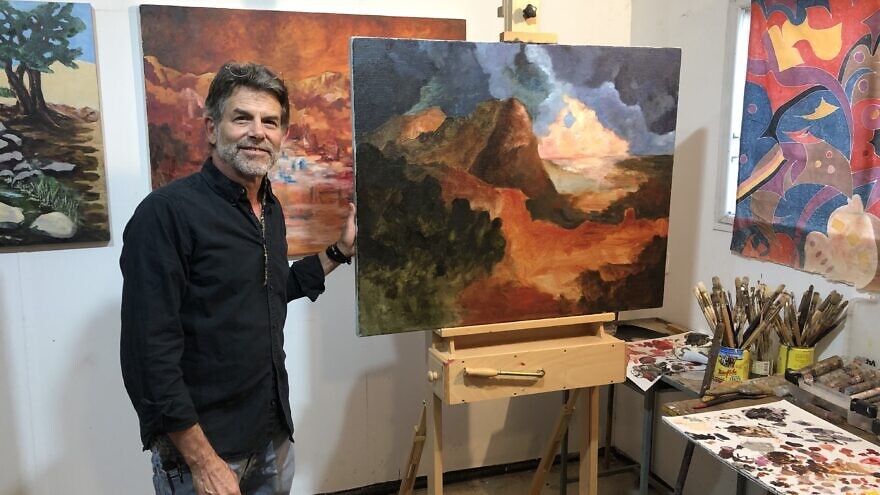
Israeli artist Marc Provisor, who spent three decades working in the field of counter-terrorism. Photo by Josh Hasten.
For more than three decades, Marc Provisor dedicated his life to keeping Israelis safe; now, he is transposing that experience onto canvas.
(JNS) The oil painting on the wall is haunting. A man in the foreground seems to be screaming in rage as a river of blood from a corpse in burial shrouds flows down a valley. Black X’s throughout represent others who have died. Yet, the sky in the background is a calming blue, buffered on one side by a lush forest and on the other an unassuming village. But it is hard to focus on beauty given the full picture.
The painting, titled “Valley of Death–Wadi Haramiya,” is the work of Marc Provisor, an Israeli artist, who put his aspiring art career on hold more than 30 years ago in order to work in the field of counter-terrorism. In this capacity, he served as the director of security for the Shiloh bloc of Jewish communities, and more recently as the director of security projects for the One Israel Fund organization.
Provisor is slowly easing out of the security realm and returning to the art world. Many of his creations are on display at an exhibit, “Return Us,” at the Ancient Shiloh tourism and heritage center in the Binyamin region of southern Samaria. The exhibit marks Provisor’s renewed focus on his true passion.
The graphic “Valley of Death” painting “helped me get out of a trauma I was experiencing,” Provisor told JNS at the show. He was referencing a 2002 incident in which a heavily armed Arab terrorist carried out a sniper attack in the Wadi Haramiya valley in Binyamin, killing 10 Israelis, including seven soldiers and three civilians. Twelve others were wounded. Provisor himself came under fire after being called to the scene as part of an operation to neutralize the terrorist.
The terrorist managed to escape but was eventually captured by Israeli security forces. The event shocked Israel, collectively, and was devastating for Provisor personally.
“I would be driving down the road and start reliving the tension of the attack, and it was getting to be too much,” he said. After consulting with a friend who was a mental health professional and reading books on post-traumatic stress disorder, Provisor decided to get back into his studio.
“This helped me find the release I needed,” he said, “and the next day, when I finished this painting, the tension was gone. This helped me reconnect to the world of art.”
Many of Provisor’s other works at the exhibit highlight the realities that Israelis under the threat of terror deal with on a daily basis–whether on the roads of Judea and Samaria, in cities, towns and villages adjacent to the Gaza Strip, or along the northern borders with Lebanon and Syria.
One painting, for example, titled “Southern Red,” depicts the situation in southern Israel from Provisor’s perspective. The work was made using pieces of Kassam rockets fired by terrorists in Gaza at Israeli communities.
This is in stark contrast to many of Provisor’s other paintings of picturesque landscapes across Israel.
“I’m not looking to push a political agenda,” he said. “I just paint what I see and the way I see it with my travels and some of the beautiful places that I go.” However, Provisor laments the fact that, as a Jew living in the Jewish state, there are places off limits to him because they are controlled by the Palestinian Authority.
His painting “Red Signs” exemplifies the large red warning signs located at the entrances to the parts of the Judea and Samaria–a territory commonly referred to as the West Bank–under full Palestinian administrative and security control. Israelis are barred from entering these places, known collectively as Area A.
Provisor argues that while technically it is “Israelis” who are banned from Area A, Arab Israelis may enter.
Just underneath “Red Signs” is another painting, titled “Looking East,” of a beautiful desert landscape. “Because of these [red] signs I’m upset that we as Jews are prevented from seeing so much beauty, and that bothers me,” said Provisor.
Provisor is also angered by Israel’s recent decision to join the European Union’s “Creative Europe” program that promotes cultural cooperation between artists from Israel and the European Union. The agreement excludes Israeli artists living in Judea and Samaria, who therefore cannot access funding otherwise made available through the joint initiative.
“I’m an Israeli citizen, I served in the army, my kids served, I pay my taxes, but the fact that … artists living over the Green Line are excluded from the program, this is a personal offense,” said Provisor. “I don’t appreciate it. It’s supposed to be a government for all the people, so I guess I’m not ‘all the people.’”
He believes that the decision to forge ahead with the agreement “gave [the Boycott, Divestment, Sanctions movement] a stamp of approval.”
Accordingly, Provisor aims to develop programs that support the artists of Judea and Samaria.
“There are a lot of really good artists here, and I want to help expose them–in a positive way–to bring a different perspective,” he told JNS.
“People think Judea and Samaria is always about disputes and violence,” he continued, “but a lot of talented artists are painting the beauty of this area, and we hope to have a lot more exhibitions and expand the opportunities for these artists to have their work on display.”
While Provisor’s primary focus is currently producing his own art, he is still involved in the security sphere. This includes sharing his knowledge of counter-terrorism with is son, who is stepping into his father’s shoes by doing a lot of field assessment work. In other words, devising solutions that keep communities in Judea and Samaria safe.
Provisor said that he is experiencing success in the art world, with his paintings on display at various exhibitions in Europe and the United States. With the added attention, he has sold some of his works.
“After all this time,” Provisor said, “I’m starting to make the dream come true.”


 Whatsapp
Whatsapp





